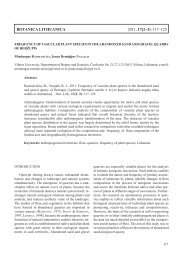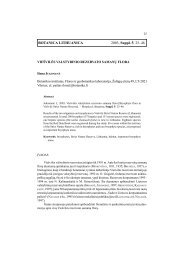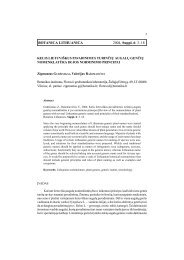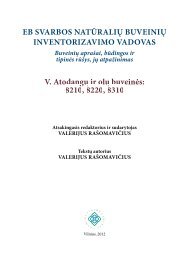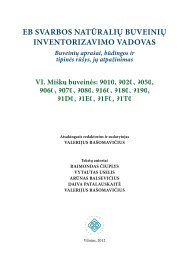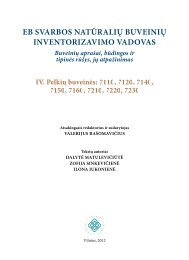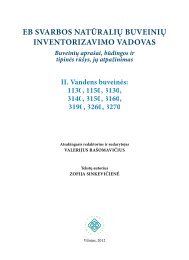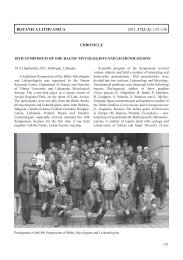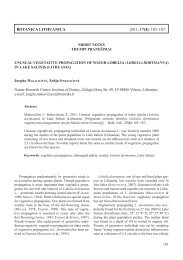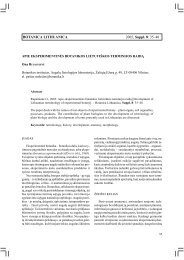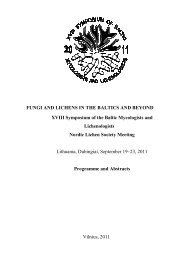BOTANICA LITHUANICA 2005, Suppl. 7: 123–129
BOTANICA LITHUANICA 2005, Suppl. 7: 123–129
BOTANICA LITHUANICA 2005, Suppl. 7: 123–129
Create successful ePaper yourself
Turn your PDF publications into a flip-book with our unique Google optimized e-Paper software.
<strong>BOTANICA</strong> <strong>LITHUANICA</strong> <strong>2005</strong>, <strong>Suppl</strong>. 7: <strong>123–129</strong><br />
USE OF BIOLOGICAL METHOD FOR DETOXIFICATION OF MYCOTOXINS<br />
Bronius BAKUTIS 1 , Violeta BALIUKONIENË 1 , Algimantas PAÐKEVIÈIUS 2<br />
1<br />
Lithuanian Veterinary Academy, Tilþës Str. 18, LT-47181 Kaunas, Lithuania; e-mail violeta.baliukoniene@lva.lt<br />
2<br />
Institute of Botany, Laboratory of Biodeterioration Research, Þaliøjø Eþerø Str. 49, LT-08406 Vilnius,<br />
Lithuania; e-mail a.paskevicius@botanika.lt<br />
Abstract<br />
Bakutis B., Baliukonienë V., Paðkevièius A., <strong>2005</strong>: Use of biological method for detoxification of<br />
mycotoxins [Biologinio metodo taikymas mikotoksinø detoksikacijai]. – Botanica Lithuanica, <strong>Suppl</strong>.<br />
7: <strong>123–129</strong>.<br />
Mycotoxins are secondary metabolites secreted by fungi, mostly belonging to the genera Aspergillus<br />
Mich. : Fr., Penicillium Link and Fusarium Link. Mycotoxin-containing feed can cause serious<br />
diseases in farm animals. The presence of mycotoxins in feed may decrease feed intake and affect<br />
animal performance. The most applied method for protecting animals against mycotoxicosis is the<br />
utilization of adsorbents mixed with the feed, which are supposed to bind the mycotoxins efficiently<br />
in the gastro-intestinal tract. The most promising approach to decontaminate feed is a biological<br />
detoxification.<br />
Keywords: adsorbents, biological detoxification, fungi, mycotoxins, yeast.<br />
INTRODUCTION<br />
Fungi are ubiquitous in nature and fulfill an essential<br />
role in the recycling of nutrients from decaying matter<br />
in soils, vegetation and water. Fungi imperfecti are known<br />
to produce variety of secondary metabolites that seem<br />
to improve their competitiveness in nature (STEYN, 1998).<br />
The primary metabolites of fungi and other organisms<br />
are those compounds that are essential for growth. Secondary<br />
metabolites are formed in the final stages of the<br />
exponential growth phase (JAY, 2000). Fungal metabolites<br />
exhibit an intrinsic toxicity even at low concentrations,<br />
resulting in their collective classification as mycotoxins<br />
(FINK-GREMMELS & GEORGIOU, 1996). Mycotoxins<br />
are unavoidable contaminants in foods and feeds and<br />
are a major problem all over the world (D’MELLO et al.,<br />
1999). The number of mycotoxins known to induce<br />
signs of toxicity in mammalian and avian species exceeds<br />
300 (FINK-GREMMELS, 1999) and is steadily increasing.<br />
Mycotoxins are important because they cause undesirable<br />
biological reactions when ingested. These reactions<br />
may vary from acute, over disease and death, to chronic<br />
disease states, and economically important but clinically<br />
obscure changes in growth, production and immunosuppression.<br />
There are thousands of secondary fungal metabolites,<br />
the vast majority of which have not been tested<br />
for toxicity or unequivocally associated with disease<br />
outbreaks (BRYDEN, 2004). The most significant mycotoxins<br />
in naturally contaminated foods and feeds are<br />
aflatoxins, ochratoxins, trichothecenes, zearalenone and<br />
fumonisins (DÄNICKE, 2002). In many cases these mycotoxins<br />
can be found in combination in food (VER-<br />
SANTVOORT et al., <strong>2005</strong>) and feed (GARALEVIÈIENË et al.,<br />
2003).<br />
Fungi of the genus Fusarium are common plant pathogens<br />
occurring world wide in a variety of crops, although<br />
they are mainly associated with cereals. Fusarium<br />
species can produce over one hundred secondary<br />
123
metabolites. The most important Fusarium mycotoxins<br />
that can frequently occur at biologically significant concentrations<br />
in cereals, are trichothecenes (deoxynivalenol,<br />
nivalenol and T-2 toxin), zearalenone, fumonisins<br />
(mainly B 1<br />
and B 2<br />
) (RICHARD, 2003). These compounds<br />
can occur naturally in agricultural food products, either<br />
individually or as specific clusters of two or more of them<br />
depending on the producing fungal species. They have<br />
been implicated alone or in combination between them<br />
and/or with other mycotoxins as the causative agents in a<br />
variety of animal diseases and have been associated to<br />
some human diseases (D’MELLO et al., 1999).<br />
The important mycotoxins produced by Aspergillus<br />
species include aflatoxins, ochratoxin, sterigmatocystin,<br />
cyclopiazonic acid. Aflatoxins are produced mainly by<br />
A. flavus, A. parasiticus and A. nominus, and are considered<br />
very potent liver carcinogens in various animal<br />
species and humans (ICMSF, 1996).<br />
According to PITT & LEISTNER (1991) Penicillium species<br />
can produce 27 different mycotoxins, with three<br />
being the most important: ochratoxins, patulin, and citrinin.<br />
Ochratoxin A is a potent nephrotoxin, teratogen,<br />
and carcinogen. Patulin produces adverse neurological<br />
and gastrointestinal effects and is produced by P. expansum.<br />
Citrinin is a nephrotoxin and is produced mainly<br />
by P. citrinum, P. expansum, and P. verrucosum (PITT,<br />
1997).<br />
Various approaches have been identified to reduce<br />
or prevent the adverse effects of mycotoxins on animal<br />
health and production. The most promising approach<br />
to decontaminate feed is the biological detoxification,<br />
the so-called biotransformation (YIANNIKOURIS & JOUA-<br />
NY, 2002). More than twenty bacteria and yeast with mycotoxins-detoxifying<br />
properties could be isolated and<br />
identified (SCHATZMAYR et al., 2004).<br />
SCHATZMAYR et al. (2004) investigated yeast of the<br />
genera Trichosporon, Rhodotorula and Cryptococcus<br />
for their ochratoxin A detoxifying activity. However,<br />
all these strains were scientifically investigated for their<br />
potential use as feed additive. At the end of a very comprehensive<br />
selection process a new yeast species currently<br />
registered as Trichosporon mycotoxinivorans came<br />
out on top. A combination of selected minerals, Eubacterium<br />
BBSH 797 strain and Trichosporon mycotoxinivorans<br />
can be used to prevent swine from mycotoxicoses<br />
caused by aflatoxins, trichothecenes, zearalenone<br />
and ochratoxin A (SCHATZMAYR et al., 2004).<br />
One product, which has been recently developed and<br />
addresses the features above, is a natural absorbent derived<br />
from the cell wall of Saccharomyces cerevisae.<br />
Modified yeast cell wall mannanoligosaccharide (MOS)<br />
has been reported to effectively bind aflatoxins, and to<br />
bind ochratoxins and the fusariotoxins to a lesser degree<br />
(DEVEGOWDA et al., 1998).<br />
The aim of this article is to present detoxifiing adsorbents<br />
for mycotoxins. In addition, we also include our<br />
results obtained during scientific studies of different<br />
yeast influence on mycotoxins in the feed.<br />
MATERIAL AND METHODS<br />
Samples of sunflower seed cake, maize, maize fodder,<br />
composed fodder were selected for the primary investigation.<br />
Fodder samples were moistened with produced<br />
medium (6.7 g/l) (Difco, Yeast nitrogen base, USA).<br />
Fodder was inoculated with Saccharomycopsis capsularis<br />
Schiöonning, Saccharomyces cerevisiae Hansen,<br />
Candida utilis (Henneberg) Kreger-van Rij, Geotrichum<br />
fermentans (Didens et Lodder) Arx, Rhodotorula rubra<br />
(Demme) Lodder, Rhodotorula glutinis (Fresenius) Harrison,<br />
Metschnikowia pulcherima Pitt et Miller, Kluyveromyces<br />
marxianus (Hansen) van der Walt yeast species.<br />
Inoculant concentration was 10 4 cell/ml. Yeast was cultivated<br />
for 10 days in a thermostat at a temperature of 28<br />
± 2 o C.<br />
Mycotoxin analysis was carried out before and after<br />
the investigation. Fodder samples were analysed by the<br />
Elisa (enzyme-linked immunosorbent assay) method<br />
(CHU, 1996). The Veratox ® Don 5/5 (Neogen, USA),<br />
Veratox ® T-2 toxin (Neogen, USA), Veratox ® Zearalenone<br />
(Neogen, USA), Veratox ® Ochratoxin (Neogen,<br />
USA), Veratox ® Aflatoxin (Neogen, USA) were used for<br />
the analysis. Mycotoxin extraction and tests were performed<br />
according to the manufacturer’s instruction. The<br />
obtained data were processed using Microsoft Excel XP.<br />
RESULTS AND DISCUSSION<br />
Recent progress in yeast biotechnology and carbohydrate<br />
chemistry has opened new avenues to highlight<br />
mycotoxin problems. The use of biological method to<br />
detoxify mycotoxins is based on elimination of the toxin<br />
(adsorption), elimination of the toxicity (biotransformation)<br />
and elimination of toxin-related effects (BAKUTIS,<br />
2004).<br />
In 1993, researchers supplemented an aflatoxin-contaminated<br />
broiler diet with 0.2 % live yeast (Yea-Sacc ®<br />
1026) and reported significant improvement in the birds’<br />
weight gain and feed efficiency (STANLEY et al., 1993).<br />
Researchers in different countries have reported beneficial<br />
effects of the inner cell wall fraction of yeast<br />
across a wide range of mycotoxins based on in vitro<br />
and in vivo tests in poultry (MANOJ & DEVEGOWDA, 2000),<br />
124
Table 1.<br />
Capacity of glucomannans from Saccharomyces cerevisae<br />
to adsorb mycotoxins (adapted from YIANNIKOURIS &<br />
JOUANY, 2002)<br />
Mycotoxins Adsorbing (%)<br />
Aflatoxins (total) 95.0<br />
Fumonisins 67.0<br />
Zearalenone 77.0<br />
T-2 toxin 33.4<br />
Citrinin 18.4<br />
Deoxynivalenol 12.6<br />
Ochratoxin A 12.5<br />
Nivalenol 8.2<br />
pigs (SWAMY et al., 2003), and dairy (WHITLOW et al.,<br />
2000).<br />
Fermentation by Saccharomyces cerevisae of wortcontaining<br />
zearalenone results in conversion of 69 %<br />
of toxin to beta-zearalenol, a metabolite of lower activity<br />
than the parent compound (KARLOVSKY, 1999).<br />
Glucomannans extracted from the external part of<br />
cell wall of the yeast Saccharomyces cerevisae are able<br />
to bind certain mycotoxins (Table 1). Their great binding<br />
capacity results from the large area available for exchange.<br />
Thus, 500 g of glucomanns from yeast cell-wall have<br />
the same adsorption capacity as 8 kg of clay (YIANNI-<br />
KOURIS & JOUANY, 2002).<br />
A feeding trial conducted with broiler chickens revealed<br />
that the negative influence of high doses of ochratoxin<br />
A on the performance of broilers could be neutralized<br />
by addition of stabilized Trichosporon spp. cells.<br />
The final weight of the group receiving 1 ppm (mg/kg)<br />
ochratoxin A and yeast (10 5 CFU per gram feed) was on<br />
average by 61 gram higher than the positive control<br />
group (1 ppm ochratoxin A without additive) (SCHATZ-<br />
MAYR et al., 2004).<br />
Incubation experiments with new yeast strain Trichosporon<br />
mycotoxinivorans showed that zearalenone<br />
could also be successfully degraded. Tests with animal<br />
cell cultures carried out at Utrecht University (the Netherlands)<br />
have already shown that samples, incubated<br />
with the yeast strain and zearalenone for a certain period<br />
of time did no longer show estrogenic effects (SCHAT-<br />
ZMAYR et al., 2004).<br />
Now various mycotoxin-detoxifying adsorbents are<br />
suggested in Lithuania. The mycotoxin adsorbents with<br />
yeast, yeast cell wall constituents are presented on Table 2.<br />
Many adsorbents were tested for binding of several<br />
mycotoxins both in vitro and in vivo. The degree of ad-<br />
Table 2.<br />
Mycotoxin adsorbents with yeast<br />
Name of adsorbent<br />
Toxy-nil dry<br />
Sorbic acid, citric acid; calcium<br />
propionate; copper sulphate;<br />
Inactivated yeast<br />
(Saccharomyces cerevisiae)<br />
Mycofix plus 3.0<br />
Inactivated yeast (specific types<br />
of Saccharomyces),<br />
diatomaceous earth (E551 c),<br />
caolinite clay, free of asbestus<br />
(E559)<br />
Mycosorb<br />
Brewers dried yeast; dried<br />
Saccharomyces cerevisiae<br />
fermentation solubles<br />
Bio-mos<br />
Brewers dried yeast; dried<br />
Saccharomyces cerevisiae<br />
fermentation solubles<br />
Toxy-nil plus dry<br />
Copper sulphate; HSCAS<br />
(sepiolite, bentonite); dried<br />
yeast (Saccharomyces<br />
cerevisiae)<br />
Klinosan<br />
Clinoptilolite; yeast extract<br />
(Saccharomyces cerevisiae)<br />
Manufacturer<br />
Nutri-Ad<br />
International N.V.,<br />
Belgium<br />
Biomin Gesunde<br />
Tierernahrung<br />
International,<br />
Austria<br />
Alltech Hungary<br />
Kft., Hungary<br />
Alltech Hungary<br />
Kft., Hungary<br />
Nutri-Ad<br />
International N.V.,<br />
Belgium<br />
Unipoint AG,<br />
Switzerland<br />
sorption in vitro depends on the chemical nature of the<br />
mycotoxin in relation to the surface properties and the<br />
geometry of the adsorbent. If the mycotoxin is bound<br />
strongly enough to the adsorbent, its adsorption by the<br />
digestive tract will be hindered (SCHATZMAYR et al., 2004).<br />
Often mycotoxin concentrations range between 10<br />
to 100 ppb in the feed. Whilst these may not cause clinical<br />
symptoms in animals, they do, nevertheless, reduce<br />
animal performance through the effects on feed intake,<br />
weight gain, immune status and reproduction. In such<br />
situations the adsorbents should have a very high affinity<br />
for mycotoxins, so that even very low concentrations can<br />
be adsorbed (SWAMY et al., 2003).<br />
The results of present study showed that selected various<br />
yeast species can reduce the different mycotoxins,<br />
when yeast is cultivated in the various plant substrates.<br />
The cultivation of Rhodotorula rubra yeast reduced the<br />
amount of deoxynivalenol from 0.35 to 0.19 mg/kg in<br />
the sunflower seed cake in 10 days. That came to 47.7 %.<br />
125
Mycotoxin amount (mg/kg)<br />
2,5<br />
2,0<br />
1,5<br />
1,0<br />
0,5<br />
0,0<br />
2<br />
0,35<br />
0,0059 0<br />
0,19<br />
0<br />
AFL DON ZON<br />
Mycotoxin<br />
Fig. 1.<br />
The amount of mycotoxins (mg/kg) in the sunflower seed cake before and after 10 days cultivation of<br />
Rhodotorula rubra yeasts: AFL – aflatoxins, DON – deoxynivalenol, ZON – zearalenone<br />
Mycotoxin amount (mg/kg)<br />
2,5<br />
2,0<br />
1,5<br />
1,0<br />
0,5<br />
0,0<br />
2,2<br />
0,3 0,222<br />
0,015 0,0047 0,0059<br />
DON ZON OA<br />
Mycotoxin<br />
Fig. 2.<br />
The amount of mycotoxins (mg/kg) in the maize fodder before and after 10 days cultivation of Rhodotorula<br />
glutinis yeasts: OA – ochratoxins, DON – deoxynivalenol, ZON – zearalenone<br />
The amounts of aflatoxins and zearalenone disappeared<br />
(Fig. 1).<br />
Rhodotorula glutinis yeast reduced the amount of<br />
deoxynivalenol from 2.20 to 0.30 mg/kg, the amount of<br />
zearalenone – from 0.222 to 0.015 mg/kg in the maize<br />
fodder in 10 days. The amount of deoxynivalenol was<br />
reduced by 84.6 % and zearalenone – 93.2 %. This yeast<br />
species increased the amount of ochratoxins from<br />
0.0047 to 0.0059 mg/kg in the maize fodder in 10 days.<br />
That made 20.3 % (Fig. 2).<br />
Metschnikowia pulcherima yeast reduced the amount<br />
of deoxynivalenol from 0.20 to 0.09 mg/kg in the maize<br />
in 10 days. That came to 55% (Fig. 3).<br />
Geotrichum fermentans yeast reduced the amount<br />
of deoxynivalenol from 0.75 to 0.28 mg/kg, the amount<br />
of zearalenone – from 0.20 to 0.11 mg/kg in the compo-<br />
126
0,3<br />
0,2<br />
Mycotoxin amount (mg/kg)<br />
0,2<br />
0,2<br />
0,1<br />
0,1<br />
0,09<br />
0,0<br />
DON<br />
Mycotoxin<br />
Fig. 3.<br />
The amount of deoxynivalenol (mg/kg) in the maize before and after 10 days cultivation of Metschnikowia<br />
pulcherrima yeasts<br />
0,8<br />
0,75<br />
0,7<br />
Mycotoxin amount (mg/kg)<br />
0,6<br />
0,5<br />
0,4<br />
0,3<br />
0,2<br />
0,1<br />
0,0<br />
0,01<br />
0<br />
0,28<br />
0,2<br />
0,11<br />
AFL DON ZON<br />
Mycotoxin<br />
Fig. 4.<br />
The amount of mycotoxins (mg/kg) in the composed fodder before and after 10 days cultivation of Geotrichum<br />
fermentans yeasts: AFL – aflatoxins, DON – deoxynivalenol, ZON – zearalenone<br />
sed fodder in 10 days. The amount of deoxynivalenol<br />
was reduced by 62.7 % and zearalenone – 45.0 %.<br />
Aflatoxins disappeared (Fig. 4).<br />
The cultivation of Kluyveromyces marxianus yeast<br />
reduced the amount of deoxynivalenol from 0.25 to 0.14<br />
mg/kg in the composed fodder in 10 days. The amount<br />
of deoxynivalenol was reduced by 44 %. The amount of<br />
aflatoxins was lower and came to 0.0045 mg/kg in the<br />
composed fodder, this amount of aflatoxins disappeared<br />
(Fig. 5).<br />
CONCLUSIONS<br />
Biological methods are a relatively new approach<br />
to the decontamination of toxic feeds that already proved<br />
to work. They decontaminate the mycotoxins via struc-<br />
127
Mycotoxin amount (mg/kg)<br />
0,8<br />
0,7<br />
0,6<br />
0,5<br />
0,4<br />
0,3<br />
0,2<br />
0,1<br />
0<br />
0,7<br />
0,25<br />
0,18 0,14<br />
0,0045 0<br />
AFL DON ZON<br />
Mycotoxin<br />
Fig. 5.<br />
The amount of mycotoxins (mg/kg) in the composed fodder before and after 10 days cultivation of Kluyveromyces<br />
marxianus yeasts: AFL – aflatoxins, DON – deoxynivalenol, ZON – zearalenone<br />
tural changes in the mycotoxin molecule without the<br />
generation of any toxic by-products or metabolites.<br />
Furthermore, this treatment does not have any impact<br />
on the nutrient value, availability of vitamins and trace<br />
elements and the palatability is not influenced.<br />
The isolation and characterization of microorganisms<br />
(yeasts) that are able to bio-transform mycotoxins<br />
is probably the breakthrough for the practical application<br />
of biotechnology in respective decontamination<br />
processes taking place directly in the intestinal tract of<br />
animals. Biological methods described above may<br />
become the technology of choice, as enzymatic reactions<br />
offer a specific, irreversible, efficient and environmentally<br />
friendly way of detoxification that leaves neither<br />
toxic residues nor any undesired by-products.<br />
In this study, the detoxifying yeast species were selected.<br />
The cultivation of Rhodotorula rubra yeast reduced<br />
deoxynivalenol by 47.7 %, zearalenone and aflatoxins<br />
– 100 % in the sunflower seed cake. In the maize<br />
fodder, Rhodotorula glutinis yeast reduced deoxynivalenol<br />
by 84.6 % and zearalenone by 93.2 %. Metschnikowia<br />
pulcherima yeast reduced deoxynivalenol by 55 %<br />
in the maize. Geotrichum fermentans yeast reduced deoxynivalenol<br />
by 62.7 %, zearalenone – 45.0 % and aflatoxins<br />
– 100 % in the composed fodder. Kluyveromyces<br />
marxianus yeast reduced deoxynivalenol by 44 %, aflatoxins<br />
– 100 % in the composed fodder.<br />
The results of this study require further investigations.<br />
ACKNOWLEDGEMENTS<br />
This study was supported by the Lithuanian State<br />
Science and Studies Foundation.<br />
REFERENCES<br />
BAKUTIS B., 2004: Mikotoksinai gyvuliø paðaruose. –<br />
Kaunas.<br />
BRYDEN W. L., 2004: Acute and chronic toxicology of<br />
mycotoxins in animal production. – World Nutrition<br />
Forum 2004: 25–26. – Erber.<br />
RICHARD J. L., 2003: Mycotoxins: Risk in Plant, Animal<br />
and Human Systems. – Ames.<br />
CHU F. S., 1996: Recent studies on immunoassays for<br />
mycotoxins. – In: BEIER R. C., STANKER L. H. (eds.),<br />
Immunoassays for residue analysis. – Food Safety.<br />
American Chemical Society: 294–313. – Washington.<br />
DÄNICKE S., 2002: Prevention and control of mycotoxins.<br />
– World’s Poultry Science, 58: 452–475.<br />
DEVEGOWDA G., RADU M. V. L. N., NAZAR A., SWAMY H.<br />
V. L. M., 1998: Mycotoxin picture worldwide: Novel<br />
solutions for their counteraction. – Proceedings of<br />
Alltech’s 14th Annual Symposium: 241–255.<br />
D’MELLO J. P. F., PLACINTA C. M., MCDONALD A. C. M.,<br />
1999: Fusarium mycotoxins: a review of global implications<br />
for animal health, welfare and productivity.<br />
– Animal Feed Science and Technology, 80:<br />
183–205.<br />
128
FINK-GREMMELS J., GEORGIOU N. A., 1996: Risk assessment<br />
of mycotoxins for the consumer. – In: ENNEN<br />
G., KUIPER H. A., VALENTIN A. (eds.), Residues of<br />
Veterinary Drugs and Mycotoxins in Animal Products:<br />
159–174. – Wageningen.<br />
FINK-GREMMELS J., 1999: Mycotoxins: their implications<br />
for human and animal health. – Veterinary Quarterly,<br />
21: 115–120.<br />
GARALEVIÈIENË D., PETTERSSON H., AGNEDAL M., 2003:<br />
Occurrence of trichothecenes, zearalenone and ochratoxin<br />
A in cereals and mixed feed from central<br />
Lithuania. – Mycotoxin Research, 18: 77–89.<br />
ICMSF (International Commission on Microbiological<br />
Specification for Food), 1996: Toxigenic fungi: Aspergillus.<br />
– In: Microorganisms in Food 5: Characteristics<br />
of Microbial Pathogens: 347–381. – London.<br />
JAY J. M., 2000: Modern Food Microbiology. – Maryland.<br />
KARLOVSKY P., 1999: Biological detoxification of fungal<br />
toxins and its use in plant breeding, feed and food<br />
production. – Natural Toxins, 7: 1–23.<br />
MANOJ K. B., DEVEGOWDA G., 2000: Efficacy of esterified<br />
glucomannan to ameliorate the toxic effects<br />
of T-2 toxin in layer hens – an in vitro study. – Proceedings<br />
CC Worlds Poultry Congress. New Delhi,<br />
India, 4: 296.<br />
PITT J. I., LEISTNER L., 1991: Toxigenic Penicillium species.<br />
– In: SMITH J. E., HENDERSON R. S. (eds.), Mycotoxins<br />
and Animal Food: 91–99. – Boca Raton.<br />
PITT J. L., 1997: Toxigenic Penicillium spiecies. – In:<br />
DOYLE M. P., BEUCHAT L. R., MONTVILLE T. J. (eds.),<br />
Food Microbiology, Fundamentals and Frontiers:<br />
406–418. – Washington.<br />
SCHATZMAYR D., NITSCH S., BINDER E. M., TÄUBEL M.,<br />
LOIBNER A., SCHATZMAYR G., 2004: Detoxification<br />
of mycotoxins. – World Nutrition Forum 2004: 128–<br />
129. – Erber.<br />
STANLEY V. G., OJO S., WOLDESENBET S., HUTCHINSON D.<br />
H., KUBENA L. F., 1993: The use of Saccharomyces<br />
cerevisiae to suppress the effects of aflatoxicosis in<br />
broiler chicks. – Poultry Science, 72: 1867–1872.<br />
STEYN P. S., 1998: The biosynthesis of mycotoxins. –<br />
Revue de Medicine Veterinaire, 149: 469–478.<br />
SWAMY H. V., SMITH T. K., MACDONALD E. J., KARROW<br />
N. A., WOODWARD B., BOERMANS H. J., 2003: Effects<br />
of feeding a blend of grains naturally contaminated<br />
with Fusarium mycotoxins on growth and immunological<br />
measurements of starter pigs, and the efficacy<br />
of a polymeric glucomannan mycotoxin adsorbent. –<br />
Animal Science, 81: 2792–2803.<br />
VERSANTVOORT C. H., OOMEN A. G., VAN DE KAMP E.,<br />
ROMPELBERG C. J., SIPS A. J., <strong>2005</strong>: Applicability of<br />
an in vitro digestion model in assessing the bioaccessibility<br />
of mycotoxins from food. – Food Chemical<br />
Toxicology, 43(1): 31–40.<br />
WHITLOW L., DIAZ D. E., HOPKINS B. A., HAGLER W. M.,<br />
2000: Mycotoxins and milk safety: the potential to<br />
block transfer to milk. – In: LYONS T. P., JACQUES K.<br />
A. (eds.), Biotechnology in the Feed Industry: 391–<br />
408. – Loughborough Lakes.<br />
YIANNIKOURIS A., JOUANY J., 2002: Mycotoxins in feed<br />
and their fate in animals: a review. – Animal Research,<br />
51: 81–99.<br />
BIOLOGINIO METODO TAIKYMAS MIKOTOKSINØ DETOKSIKACIJAI<br />
Bronius BAKUTIS, Violeta BALIUKONIENË, Algimantas PAÐKEVIÈIUS<br />
Santrauka<br />
Mikotoksinai yra antriniai mikromicetø metabolitai.<br />
Pagrindinius mikotoksinus gamina Aspergillus Mich. : Fr.,<br />
Penicillium Link ir Fusarium Link genèiø mikromicetai.<br />
Mikotoksinais uþterðti paðarai gali sukelti pavojingø ligø<br />
gyvuliams ir paukðèiams. Mikotoksinø kiekis paðaruose<br />
trukdo ásisavinti juose esanèias maisto medþiagas ir<br />
sumaþina gyvuliø produktyvumà. Daþniausiai prieð<br />
mikotoksikozes naudojami adsorbentai, kuriø maiðoma<br />
á paðarus. Adsorbentai gyvuliø virðkinimo trakte suriða<br />
arba suskaldo mikotoksinus. Veiksmingas bûdas detoksikuoti<br />
paðarus yra biologinë detoksikacija. Straipsnyje<br />
apþvelgtas ávairiø mieliø padermiø naudojimas mikotoksinø<br />
detoksikacijai.<br />
129
130



